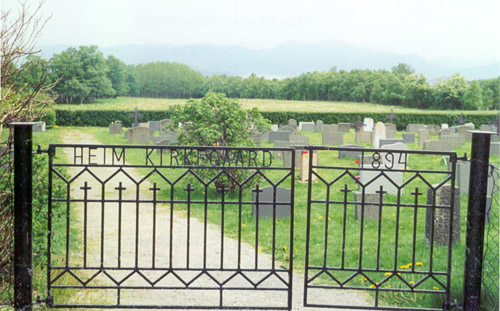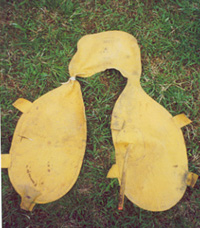W1044 ZA-D from 10 Squadron
| On 30th March 1942, the crew of Halifax W1044 ZA-D from 10 Squadron took off at 1851 hrs from RAF Lossiemouth on the North East Coast of Scotland to participate in an attack on the German Battleship Tirpitz which was moored at the time in Fættenfjord in Norway.
The 10 Squadron Operation Records Book for this date state that the aircraft failed to return and no contact was made after it took off from the advanced base. Further research has found that W1044 ZA-D flown by Pilot Officer Blunden and crew crashed in the water somewhere in the Hemnefjord area, 40 miles west of Trondheim. The bodies of Pilot Officer Day, Sergeant Richards and Sergeant May were recovered from the water in the days immediately after the crash. They were buried on April 4th in the graveyard at Heim.
|
|
Rank
|
Name
|
Force | Crew Position | Age |
Home Town
|
Fate |
| P/O | BLUNDEN N R | RNZAF | Pilot | 26 | Greymouth, Westland, New Zealand | Died |
| P/O | DAY G C | RAFVR | 2nd Pilot | 28 | UK | Died |
| Sgt | EASTWOOD W B | RAFVR | Navigator | 25 | Stamford Hill, London, England | Died |
| F/Sgt | FRANKLIN H R | RCAF | W/Op Air Gunner | 28 | Stratford, Ontario, Canada | Died |
| Sgt | MAY K C | RAFVR | W/Op Air Gunner | 19 | Newcastle, England | Died |
| Sgt | HENMAN A R | RCAF | Tail Gunner | 26 | Sudbury, Ontario, Canada | Died |
| Sgt | RICHARDS R G A | RAF | Flight Engineer | Died |
 |
|
Photo: M Moe
|
| Two 10 Squadron aircraft crashed in the Hemnefjord area on the night of 30/31st March 1942. W1044 ZA-D flown by Pilot Officer N R Blunden and W1043 ZA-F flown by Squadron Leader Webster. Most of the aircraft taking part in the raid that night would have flown over this area on their way either to or from the target therefore many of the locals living there were disturbed by the noise of aircraft flying that night. 10 Squadron were flying in phase two of the operation, and each aircraft had a load of four 1,000 lb mines onboard.
Some of the local people in Heimsjøen can remember seeing a large aircraft coming from the South West flying very low. They could hear that the aircrafts engines were coughing and spluttering which would indicate that it was having trouble with the engines and thus maintaining height. German troops stationed in the Olderbakken/Myran area fired at the aircraft with machine guns which had little effect and it appears that the aircraft was already damaged. The aircraft ditched in the waters of Hemnefjord just offshore from Hannasteinen and exploded either as it hit the water or shortly after hitting the water. Early the next morning, a fisherman called Kvam and his stepson, Kåre, were out in their boat to check their nets which were in a bay just North of Heimsjøen. On arriving at the bay they discovered a dinghy and aircraft debris on the shore. They found the bodies of two airmen and more debris in the water very close to their nets. After first hiding the dinghy, they walked to Sætervika Farm where they made a telephone call to the Germans stationed at Heim informing them that they had discovered two bodies. The bodies were recovered by the Germans and placed on the shoreline between Sætervika and Oterneset to await the arrival of coffins. Gudliev Olsen from Heimsjen was also out in his boat that morning. He discovered aircraft debris in the water and after searching for a while he saw the body of an airman in the water. The body was recovered and placed on the shore between Sætervika and Oterneset with the others.
The Youth Association, Våren, at Heim, talked to the Germans in order to seek permission for the airmen to be buried in the local cemetery at Heim. This was permitted, and a local man from Heim who had ground reserved in the cemetery for his family agreed to allow the airmen to be buried in his plot. Three coffins were brought for the airmen, and it is said that one was white, one was black and the third unpainted wood. However, before the bodies could be collected from the shore the weather became very stormy with high winds and rough seas making it impossible to get to the shore where they lay. Two days later, on Thursday 2nd April, the weather abated, but the sea had claimed the bodies from the shore where they had been left and they had to be recovered once more. Local men, Oddmund Vitsø, Trygve Vitsø, Henry Moe and others assisted with the recovery and took the airmen to the cemetery.
In the days after the crash many people in the surrounding areas found aircraft debris and wreckage in the fjord or washed up on the shores. Some of the debris and wreckage could also have come from the 10 Squadron aircraft W1043 ZA-F which crashed nearby on the same night. A considerable amount of dead fish were also washed ashore, presumably having been killed when the aircraft exploded on the fjord, or possibly by the mines that the aircraft may still have had onboard at this time.
On Saturday 4th April 1942, the three airmen were buried in the cemetery at Heim. They had been identified as being Pilot Officer G C Day, the Second Pilot, Sergeant K C May, one of the Wireless Operators and Sergeant R G A Richards the Flight Engineer, all crew members from the Halifax W1044 ZA-D. The bodies of the remainder of the crew were never found. On April 8th 1942 the three airmen from 35 Squadron Halifax, R9496 TL-L, Flight Sergeant Archibald, Sergeant McLaren and Sergeant Francis, were buried at Trondheim Stavne Cemetery along with Flight Sergeant Steinhauer from 35 Squadron who was the pilot of Halifax W1015 TL-P and Squadron Leader Webster from 10 Squadron, pilot of Halifax W1043 ZA-F also shot down on the night of 30/31st March 1942 in other areas. In 1946, the RAF Missing Research and Enquiry Service (MRES) visited the Heim area to conduct an investigation into the loss of the aircraft. The investigation was conducted by Flight Lieutenant J W Willis-Richards. He located the graves of Day, May and Richards in the cemetery at Heim and made enquiries in the area about the fate of the other crew members. It was concluded that the remainder of the crew were lost with the aircraft when it submerged. Flight Lieutenant Willis-Richards also reported that local people had volunteered to look after the airmen's graves and keep them in good order. The case was considered closed on April 9th 1946. Some time later in 1946 the three airmen were moved from Heim and reburied in Trondheim Stavne Cemetery where so many of the other airmen who lost their lives during operations against Tirpitz lie. Pilot Officer Blunden*, the Pilot, Sergeant Eastwood, the Navigator, Flight Sergeant Franklin, the Wireless Operator and Sergeant Henman, the Tail Gunner were never found and they are commemorated on the Runnymede Memorial, Surrey in England. Pilot Officer Day, Sergeant May and Sergeant Richards are now buried in Trondheim Stavne Cemetery in Trondheim. My special thanks to Morten Moe in Norway for his help in researching the loss of this aircraft. * The diary of P/O Neil Blunden from when he sailed from NZ on 29th April 1941 to the UK via Canada until the day before his death can now be read on this website. Click here to read the diary of P/O Neil R. Blunden RNZAF. |
© Linzee Druce 2001-2012


